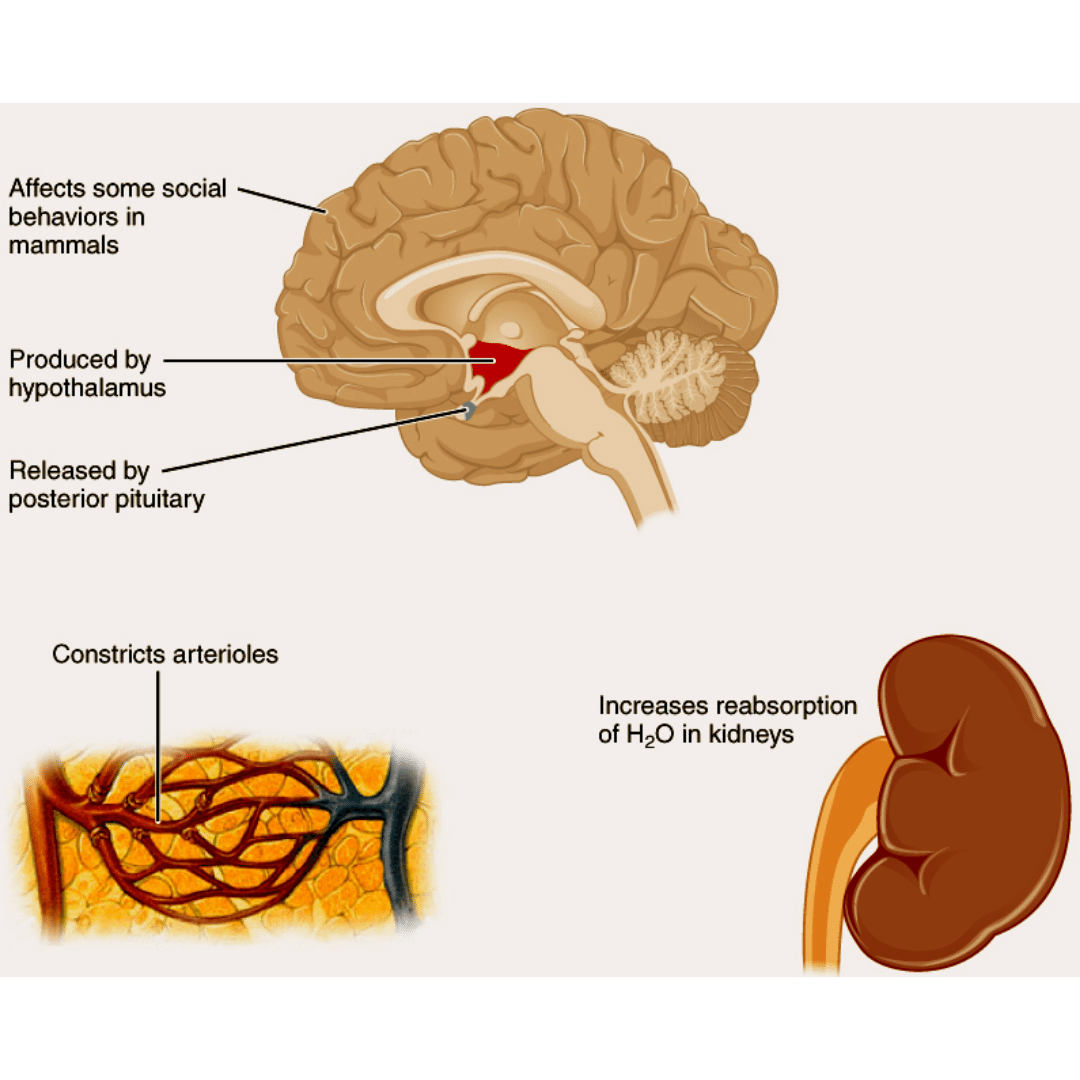Introduction
Antidiuretic hormone (ADH), also known as vasopressin or arginine vasopressin, is generated in the brain and stored in the posterior pituitary gland. It primarily regulates fluid output of the body by allowing the kidneys to reabsorb water during the process of ultrafiltration of blood. It is known as a nonapeptide since it is a peptide hormone made up of nine amino acids. The hypothalamus’s osmoreceptors detect the blood’s high solute concentration (high solute is an indication of low fluid) and indicate the release of ADH hormone.

Functions
The functions of ADH hormone are as follows-
- Diuretic refers to substances that can increase the water content in the urine. ADH, an antidiuretic hormone, lowers this water content during urine production.
- ADH action allows the reabsorption of water from the collecting tubules by increasing their permeability towards water.As a result, it only permits very little urine to leave the body.
- ADH contributes to maintaining the homeostasis of the body, necessary for healthy cellular activity.
- ADH causes blood arteries to contract, which raises blood pressure.Blood flows with higher pressure because of constriction of the lumen of the blood arteries.
Regulation
ADH is regulated by the hypothalamus, the master gland.
- The baroreceptors found in blood vessels close to the heart transmit information to the brain in cases of severe blood loss caused by blood vessel damage that results in a brief state of hypovolemia.
- During Summertime there is a high solute concentration in the blood. This occurs because of the heavy sweating and extremely high daytime temperatures.
- This situation is detected by osmoreceptors in the hypothalamus, which alerts the brain to it to maintain a healthy cellular environment.
- For this, the brain instructs various hormones in the body which will help to prevent water loss.
- Low fluid and high solute levels cause the posterior pituitary gland to release the ADH hormone. This hormone acts on nephrons in the kidneys specifically, the collecting ducts and thus allowing water retention.
Disorders
Hypothermia
- It develops when the body secretes too much ADH, which causes the kidneys to retain more water while salts continue to be eliminated normally from the body.
- This leads to a cellular condition known to have low salt concentration and high fluid content (low sodium in the bloodstream) arises which is also known as hypothermia.
- This condition might result from a tumour of some kind that releases excess of ADH in the body.
- Drug side effects may also cause this disease to develop.
Central Diabetes insipidus-
- When ADH levels fall below the normal range, water retention is inhibited.
- This is so, because the collecting ducts become water-impermeable and as a result, discharged urine which has a high fluid content.
- Such a condition is known as Central diabetes insipidus.
- This may occur as a result of infection, inflammation,injury ,surgery or brain trauma, in the hypothalamus, or the posterior pituitary gland or both of them.
Nephrogenic Diabetes Insipidus-
- Nephrogenic diabetes insipidus develops when the kidneys become resistant to ADH, either as a result of signal mediator or nephron receptor malfunction.
- This disease occurs because even though ADH is readily available, it cannot bind to the target site and carry out its metabolic function.
Summary
Through the consumption of meals and liquids, the body receives water continuously. While some water is lost by perspiration through the skin, the majority is excreted as urine. The continuation of life processes depends on the maintenance of the water balance. This water balance in the body is maintained by ADH-Antidiuretic hormone which helps in water retention in the body and maintains the steady state of the body.
Frequently Asked Questions
1. What are edema and dehydration?
Edema is the condition of excessive water retention. Dehydration is excessive water loss or very little water intake. Neither of these states is an indication of a healthy person.
2. What is difference between diabetes Diabetes insipidus and diabetes mellitus?
Low ADH levels cause the polyuria and polydipsia condition known as diabetes insipidus. High blood glucose levels brought on by inadequate pancreatic insulin secretion are known as diabetes mellitus.
3. How can alcohol consumption affect ADH?
The secretion of ADH is inhibited by alcohol intake. This causes an increased urine production and dehydration in the body. It leads to symptom of severe headaches.
 Mission Statement
Mission Statement
“Empower every student to achieve full potential”
88Guru has been established with the social objective of making quality video-based learning material available to all Indian students. Technology, Connectivity and Social Media are rapidly changing the world of Education and we wish to lead the transformation of the tuition industry in India.
88Guru is the perfect complement to the current tuition model. 88Guru creates a wonderful opportunity for children and parents to bond while engaging in a valuable learning activity. It also provides the complete curriculum at your fingertips for those moments when you need some help at short notice. We believe that this mode of tuition could be transformational, adding hours to a child's day while providing complete control over the learning process.
Every course is taught by the best teachers from India's top schools and conducted in an engaging manner to keep students involved. The e-learning process consists of video-based instructions, computer-graded assignments, and a dashboard which allows the student and parent to track progress.


